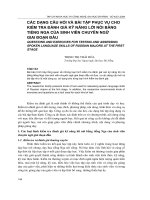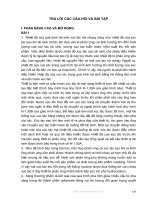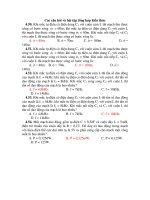CÁC MẪU CÂU THƯỜNG GẶP(CÓ BÀI TẬP)
Bạn đang xem bản rút gọn của tài liệu. Xem và tải ngay bản đầy đủ của tài liệu tại đây (70.39 KB, 8 trang )
Một số mẫu câu thường gặp
1. Cấu trúc câu mang nghĩa bao hàm
– Đó là lối nói gộp hai ý trong câu làm một thông qua một số các cụm
từ. Hai thành phần trong câu phải tương đương nhau về mặt từ loại:
danh từ với danh từ, tính từ với tính từ, ...
1.1. Not only ..... but also (không những ... mà còn....)
S + verb + not only + noun/adj/adv + but also + noun/adj/adv
Hoặc:
S + not only verb + but also + verb
Robert is not only talented but also handsome.
He writes not only correctly but also neatly.
She can play not only the guitar but also the violin.
She not only plays the piano but also composes music.
Thành phần sau 'but also' thường quyết định thành phần sau 'not only'.
Incorrect: He is not only famous in Italy but also in Switzerland.
Correct: He is famous not only in Italy but also in Switzerland.
1.2. As well as (vừa ... vừa ...)
– Cũng giống như cấu trúc trên, các thành phần đằng trước và đằng sau
cụm từ này phải tương đương với nhau.
S + verb + noun/adj/adv + as well as + noun/adj/adv
Hoặc:
S + verb + as well as + verb
Ví dụ:
Robert is talented as well as handsome.
He writes correctly as well as neatly.
She plays the guitar as well as the violin.
Paul plays the piano as well as composes music.
Chú ý: Không được nhầm thành ngữ này với as well as của hiện tượng
đồng chủ ngữ mang nghĩa cùng với.
The teacher, as well as her students, is going to the concert.
My cousins, as well as Tim, have a test tomorrow.
1.3. Both ..... and... (vừa ... vừa)
– Công thức dùng giống hệt như not only .... but also. Both chỉ được
dùng với and, không được dùng với as well as.
Robert is both talented and handsome.
Paul both plays the piano and composes music.
2. Một số cấu trúc câu cầu khiến
2.1. To have sb do sth = to get sb to do sth = khiến ai, bảo ai làm gì
I’ll have Peter fix my car.
I’ll get Peter to fix my car.
2.2. To have/to get sth done = làm một việc gì bằng cách thuê người
khác
1
I have my hair cut. (Tôi đi cắt tóc - chứ không phải tôi tự cắt)
I have my car washed. (Tôi mang xe đi rửa ngoài dịch vụ - không phải
tự rửa)
Theo khuynh hướng này động từ to want và would like cũng có thể dùng
với mẫu câu như vậy: To want/ would like Sth done. (ít dùng)
I want/ would like my car washed.
2.3. To make sb do sth = to force sb to do sth = Bắt buộc ai phải làm gì
The bank robbers made the manager give them all the money.
The bank robbers forced the manager to give them all the money.
Đằng sau tân ngữ của “make” có thể dùng 1 tính từ: To make sb/sth +
adj
Wearing flowers made her more beautiful.
Chemical treatment will make this wood more durable
2.4. To make sb + P2 = làm cho ai bị làm sao
Working all night on Friday made me tired on Saturday.
2.5. To cause sth + P2 = làm cho cái gì bị làm sao
The big thunder storm caused many waterfront houses damaged.
2.6. To let sb do sth = to permit/allow sb to do sth = để cho ai, cho
phép ai làm gì
I let me go.
At first, she doesn’t allow me to kiss her but...
3. Lối nói phụ họa
3.1. Phụ họa câu khẳng định
– Khi muốn nói một người hoặc vật nào đó làm một việc gì đó và một
người, vật khác cũng làm một việc như vậy, người ta dùng so hoặc too.
Để tránh phải lặp lại các từ của câu trước (mệnh đề chính), người ta
dùng liên từ and và thêm một câu đơn giản (mệnh đề phụ) có sử dụng
so hoặc too. Ý nghĩa của hai từ này có nghĩa là “cũng thế”.
John went to the mountains on his vacation, and we did too.
John went to the mountains on his vacation, and so did we.
I will be in Vietnam in May, and they will too.
I will be in Vietnam in May, and so will they.
He has seen her play, and the girls have too.
He has seen her play, and so have the girls.
We are going to the movie tonight, and he is too.
We are going to the movie tonight, and so is he.
She will wear a custom to the party, and we will too.
She will wear a custom to the party, and so will we.
Picaso was a famous painter, and Rubens was too.
Picaso was a famous painter, and so was Rubens.
Tuỳ theo từ nào được dùng mà cấu trúc câu có sự thay đổi:
– Khi trong mệnh đề chính có động từ be ở bất cứ thời nào thì trong
mệnh đề phụ cũng dùng từ be ở thời đó.
2
Affirmative statement (be) + and + S + verb + too
Affirmative statement (be) + and + so + verb + S
I am happy, and you are too.
I am happy, and so are you.
– Khi trong mệnh đề chính có một cụm trợ động từ + động từ], ví dụ
will go, should do, has done, have written, must consider, ... thì các trợ
động từ trong mệnh đề đó được dùng lại trong mệnh đề phụ.
They will work in the lab tomorrow, and you will too.
They will work in the lab tomorrow, and so will you.
– Khi trong mệnh đề chính không phải là động từ be, cũng không có trợ
động từ, bạn phải dùng các từ do, does, did làm trợ động từ thay thế.
Thời và thể của trợ động từ này phải chia theo chủ ngữ của mệnh đề
phụ.
Affirmative statement + and + S + do/does/did + too
Affirmative statement + and + so + do/does/did + S
Jane goes to that school, and my sister does too.
Jane goes to that school, and so does my sister.
3.2. Phụ hoạ câu phủ định
– Cũng giống như too và so trong câu khẳng định, để phụ hoạ một câu
phủ định, người ta dùng 'either' (cũng) hoặc 'neither' (cũng không). Ba
quy tắc đối với trợ động từ, động từ be hoặc do, does, did cũng được áp
dụng giống như trên. Ta cũng có thể gói gọn 3 quy tắc đó vào một công
thức như sau:
Negative statement + and + S + negative auxiliary (or be) + either
Negative statement + and + neither + positive auxiliary (or be) + S
I didn't see Mary this morning, and John didn't either
I didn't see Mary this morning, and neither did John.
She won’t be going to the conference, and her friends won’t either.
She won’t be going to the conference, and neither will her friends.
John hasn’t seen the new movie yet, and I haven’t either.
John hasn’t seen the new movie yet, and neither have I.
4. Các cấu trúc khác
4.1. Enough: đủ….để có thể làm gì
• Đi với tính từ hoặc trạng từ, enough thường đứng sau:
S + verb + adv + enough + (for somebody) + to + verb…
S + tobe + adj + enough + (for somebody) + to + verb….
Ví dụ:
Coffee is hot enough for me to drink
This exercise is easy enough for us to do.
This motorbike drives fast enough to Ha Dong.
• Đi với danh từ, enough thường đứng trước:
S + verb + enough + noun (for somebody) + to verb…
S + verb + enough + for something
Ví dụ:
3
I have enough money to buy a car.
They grow enough rice to live.
It’s enough time for us to do the exercise.
Have you got enough vegetable for dinner?
Do you have enough sugar for the cake?
4.2. Too…: quá để có thể làm gì.
Cấu trúc này điễn tả mức độ vượt quá khả năng để làm gì đó
Cấu trúc:
S + verb + too + adv + (for somebody) + to + verb ….
S + tobe + too + adj + (for somebody) + to + verb…
Ví dụ:
The coffee is too hot for me to drink.
He is too young to love.
He spoke too quickly for us to understand.
The bus drives too fast for us to keep pace with.
4.3. So/such….that….: đến nỗi mà
• So ….that….
Cấu trúc: S + tobe + so + adj + that + a clause
S + verb + so + adv + that + a clause
Ví dụ:
The exercise is so difficult that I can’t do it.
The food is so hot that we can’t eat it.
He spoke so quickly that I can’t hear him.
The bus drives so fast that they can’t catch it.
• Such…that…
Cấu trúc:
S/it + tobe + such + (a/an)+ adj + noun + that + a clause
S/it + verb + such + (a/an) + adj + noun + that + a clause
Ví dụ:
It is such a difficult exercise that we can’t do it.
We bought such a modern car that we couldn’t dream.
Chú ý: nếu danh từ là không đếm được thì không dùng “a/an”
This is such difficult homework that we can’t finish it.
He invested such much money that we couldn’t imagine.
4.4. Adj + to verb
Cấu trúc: It + tobe + adj + for somebody + to verb….
Ví dụ:
It’s necessary for us to protect environment.
It’s difficult for him to pass the exam.
4.5. It’s + adj + of + object + to + verb….
Ví dụ:
It’s kind of him to help me = He is kind to help me.
(anh ta thật tốt bụng vì đã giúp đỡ tôi)
4
It’s cowardly of him to run away= he is cowardly to run away.
(anh ta thật hèn nhát vì đã bỏ chạy)
4.6. It takes/took + object + khoảng thời gian + to verb… .
= somebody spend/spent + khoảng thời gian + V-ing…: mất bao lâu để
ai đó làm việc gì.
Ví dụ:
It takes me 15 minutes to go to school by bike.
= I spend 15 minutes going to school by bike.
It took him a year to study English
= He spent a year studying English.
It took her 2 hours to type this document.
= She spent 2 hours typing this document.
4.7. It’s + khoảng thời gian + since + clause (simple past): được
bao lâu từ khi……
Ví dụ:
It’s a week since I saw Nam
It’s a year since they visited me.
It’s ages since it rained here.
4.8. It’s the first time + clause (present perfect): đây là lần đầu
tiên….
= ……..before
Ví dụ:
It’s the first time I’ve ever visited this town.
= I’ve never visited this town before.
It’s the first time he has ever sent me a letter.
= He has never sent me a letter before.
It’s the first time she has ever arrived late.
= She has never arrived late before.
4.9. It is/was not until + time + that + clause : mãi cho đến
khi………..
Ví dụ:
It was not until 1990 that she became a teacher. (mãi đến năm 1990,cô
ấy mới trở thành giáo viên)
It was not until 1915 that the cinema really became an industry.
(mãi đến năm 1915 điện ảnh mới thực sự trở thành một ngành công
nghiệp)
Bài tập 1: Phụ họa với những câu dưới đây:
Ví dụ: Nam likes fish. (I) –> Nam likes fish, so do I.
1. He came early, (she)
2. She knows you quite well, (her husband)
3. My friend lived in Hai Phong, (his sister)
4. These books don’t belong to me, (those)
5. I don’t believe it, (my friend)
5









